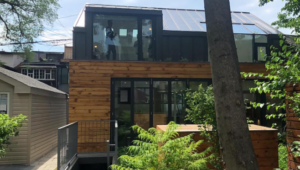Laneway housing is a way to gently increase density, but it’s not necessarily an affordable housing solution
This is from Toronto’s Now Magazine.
We do want to caution the reader; a part of this story talks about “the laneway suite providing two or three units of rental income”. That refers to buying or owning a home that already has one or two rental unit possibilities in the existing main house, and the laneway house providing the second or third income. Each laneway house can only normally have just one paying tenant (person, couple or family), except in very exceptional circumstances. ~ Marty
Laneway housing has long been touted as a key component to gently increase density – or as planners put it, a “missing middle” housing solution. However, prior to 2018, building laneway housing in Toronto was a logistical nightmare.
“Our planning bylaws heavily favour single family development,” says Philip Kocev, a broker and managing officer at iPro Realty Ltd who has been advocating for more multi-unit dwellings similar in scale to single-family and detached homes. “You could take a piece of land and build a big monster house; you can take your historic bungalow and put two levels on it super easily. But the minute you go into two or more units, it’s really challenging to go through the city process.”

Toronto finally passed a bylaw in 2018 to make laneway suites much easier to build for developers (“suite” is the key word there; redefining laneway houses as suites allows them to be considered detached secondary units whose services are still connected to the main unit). Shortly after, the city started its own laneway suite project to work on expanding housing options.
The market is now ripe for laneway housing. Whether you’ve considered renting a laneway suite or building your own behind your home, here’s how you do it.
Laneway developments can serve a few different demographics. Kocev sees these developments catering to two groups: younger professionals who might be looking to start families or need a little more space than a downtown condo as they settle down, and the aging population in the city (50-plus) looking to move while also creating opportunities for multi-generational housing.
Kocev says making the move to a semi-detached home for a young family means paying over a million dollars, so laneway housing can bring them closer to schools while offering a more affordable entry level into the market. Older couples looking to downsize but still wanting space for kids and grandkids to visit might invest in a laneway development, staying in the main unit and renting out the secondary one for extra income.
MORE at Toronto’s Now Magazine

